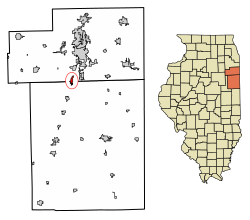Chebanse, Illinois
Chebanse, Illinois | |
|---|---|
 Location of Chebanse in Iroquois County, Illinois | |
 Location of Illinois in the United States | |
| Coordinates: 41°00′02″N 87°54′37″W / 41.00056°N 87.91028°W[1] | |
| Country | United States |
| State | Illinois |
| Counties | Iroquois, Kankakee |
| Townships | Chebanse, Otto |
| Area | |
• Total | 1.19 sq mi (3.08 km2) |
| • Land | 1.19 sq mi (3.08 km2) |
| • Water | 0.00 sq mi (0.00 km2) |
| Elevation | 666 ft (203 m) |
| Population (2020) | |
• Total | 1,044 |
| • Density | 877.31/sq mi (338.86/km2) |
| Time zone | UTC-6 (CST) |
| • Summer (DST) | UTC-5 (CDT) |
| ZIP Code(s) | 60922 |
| Area code | 815 |
| FIPS code | 17-12801 |
| GNIS feature ID | 2397609[1] |
| Wikimedia Commons | Chebanse, Illinois |
| Website | www |
Chebanse is a village in Iroquois and Kankakee counties in the U.S. state of Illinois. The population was 1,044 at the 2020 census. The Kankakee County portion of Chebanse is included in the Kankakee-Bradley, Illinois Metropolitan Statistical Area.
Geography
[edit]Chebanse is located on the border between Iroquois and Kankakee counties. Interstate 57 passes the eastern edge of the village, with access from Exit 302. I-57 leads north 9 miles (14 km) to Kankakee and south 65 miles (105 km) to Champaign. Chicago is 68 miles (109 km) north of Chebanse.
According to the 2021 census gazetteer files, Chebanse has a total area of 1.19 square miles (3.08 km2), all land.[3]
Chebanse is partly located in Iroquois County, but a portion extends northward into Kankakee County, thus into the Chicago metropolitan area.
History
[edit]Chebanse was established in 1854 as the first stop on the Illinois Central Railroad south of Kankakee.
"Chebanse" derives from zhishibéns, meaning "the little duck" in the Potawatomi language.[4][5]
Demographics
[edit]| Census | Pop. | Note | %± |
|---|---|---|---|
| 1880 | 723 | — | |
| 1890 | 616 | −14.8% | |
| 1900 | 555 | −9.9% | |
| 1910 | 590 | 6.3% | |
| 1920 | 541 | −8.3% | |
| 1930 | 523 | −3.3% | |
| 1940 | 603 | 15.3% | |
| 1950 | 739 | 22.6% | |
| 1960 | 995 | 34.6% | |
| 1970 | 1,185 | 19.1% | |
| 1980 | 1,191 | 0.5% | |
| 1990 | 1,082 | −9.2% | |
| 2000 | 1,148 | 6.1% | |
| 2010 | 1,062 | −7.5% | |
| 2020 | 1,044 | −1.7% | |
| U.S. Decennial Census[6] | |||
As of the 2020 census[7] there were 1,044 people, 479 households, and 343 families residing in the village. The population density was 877.31 inhabitants per square mile (338.73/km2). There were 443 housing units at an average density of 372.27 per square mile (143.73/km2). The racial makeup of the village was 91.57% White, 0.67% African American, 0.10% Native American, 0.57% Asian, 0.00% Pacific Islander, 1.53% from other races, and 5.56% from two or more races. Hispanic or Latino of any race were 3.64% of the population.
There were 479 households, out of which 34.7% had children under the age of 18 living with them, 50.52% were married couples living together, 8.14% had a female householder with no husband present, and 28.39% were non-families. 22.76% of all households were made up of individuals, and 11.90% had someone living alone who was 65 years of age or older. The average household size was 2.80 and the average family size was 2.52.
The village's age distribution consisted of 24.9% under the age of 18, 7.7% from 18 to 24, 32.3% from 25 to 44, 21% from 45 to 64, and 14.1% who were 65 years of age or older. The median age was 36.4 years. For every 100 females, there were 115.3 males. For every 100 females age 18 and over, there were 114.9 males.
The median income for a household in the village was $73,239, and the median income for a family was $80,302. Males had a median income of $40,195 versus $35,083 for females. The per capita income for the village was $31,063. About 4.1% of families and 4.1% of the population were below the poverty line, including 8.6% of those under age 18 and 7.1% of those age 65 or over.
Notable people
[edit]- Harold Gray, creator of the Little Orphan Annie comic strip, grew up on a farm near Chebanse
References
[edit]- ^ a b c U.S. Geological Survey Geographic Names Information System: Chebanse, Illinois
- ^ "2020 U.S. Gazetteer Files". United States Census Bureau. Retrieved March 15, 2022.
- ^ US Census Bureau. "Gazetteer Files". Census.gov. Retrieved 2022-06-29.
- ^ "The People of the Prairie", Charles Warwick, The Illinois Steward, vo. 16, no. 2, 2007
- ^ Illinois Central Magazine. Illinois Central Railroad Company. 1922. p. 45.
- ^ "Census of Population and Housing". Census.gov. Retrieved June 4, 2015.
- ^ "Explore Census Data". data.census.gov. Retrieved 2022-06-28.



